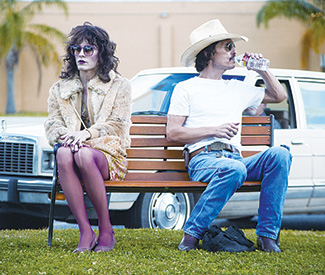joe@sfbg.com
This year’s annual Project Censored list of the most underreported news stories includes the widening wealth gap, the trial of Pfc. Bradley Manning for leaking classified documents, and President Obama’s war on whistleblowers — all stories that actually received considerable news coverage.
So how exactly were they “censored” and what does that say of this venerable media watchdog project?
Project Censored isn’t only about stories that were deliberately buried or ignored. It’s about stories the media has covered poorly through a sort of false objectivity that skews the truth. Journalists do cry out against injustice, on occasion, but they don’t always do it well.
That’s why Project Censored was started back in 1976: to highlight stories the mainstream media missed or gave scant attention to. Although the project initially started in our backyard at Sonoma State University, now academics and students from 18 universities and community colleges across the country pore through hundreds of submissions of overlooked and underreported stories annually. A panel of academics and journalists then picks the top 25 stories and curates them into themed clusters. This year’s book, Censored 2014: Fearless Speech in Fearful Times, hits bookstores this week.
What causes the media to stumble? There are as many reasons as there are failures.
Brooke Gladstone, host of the radio program On the Media and writer of the graphic novel cum news media critique, The Influencing Machine, said the story of Manning (who now goes by the first name Chelsea) was the perfect example of the media trying to cover a story right, but getting it mostly wrong.
“The Bradley Manning case is for far too long centered on his personality rather than the nature of his revelations,” Gladstone told us. Manning’s career was sacrificed for sending 700,000 classified documents about the Iraq war to WikiLeaks. But the media coverage focused largely on Manning’s trial and subsequent change in gender identity.
Gladstone said that this is part of the media’s inability to deal with vast quantities of information which, she said, “is not what most of our standard media does all that well.”
The media mangling of Manning is number one on the Project Censored list, but the shallow coverage this story received is not unique. The news media is in a crisis, particularly in the US, and it’s getting worse.
WATCHING THE WATCHDOGS
The Project for Excellence in Journalism, which conducts an annual analysis of trends in news, found that as revenue in journalism declined, newsrooms have shed 30 percent of their staff in the last decade. In 2012, the number of reporters in the US dipped to its lowest level since 1978, with fewer than 40,000 reporters nationally. This creates a sense of desperation in the newsroom, and in the end, it’s the public that loses.
“What won out is something much more palpable to the advertisers,” says Robert McChesney, an author, longtime media reform advocate, professor at University of Illinois, and host of Media Matters from 2000-2012. Blandness beat out fearless truth-telling.
Even worse than kowtowing to advertisers is the false objectivity the media tries to achieve, McChesney told us, neutering its news to stay “neutral” on a topic. This handcuffs journalists into not drawing conclusions, even when they are well-supported by the facts.
In order to report a story, they rely on the words of others to make claims, limiting what they can report.
“You allow people in power to set the range of legitimate debate, and you report on it,” McChesney said.
Project Censored stories reflect that dynamic — many of them require journalists to take a stand or present an illuminating perspective on a set of dry facts. For example, reporting on the increasing gulf between the rich and the poor is easy, but talking about why the rich are getting richer is where journalists begin to worry about their objectivity, Gladstone said.
“I think that there is a desire to stay away from stories that will inspire rhetoric of class warfare,” she said.
Unable to tell the story of a trend and unable to talk about rising inequality for fear of appearing partisan, reporters often fail to connect the dots for their readers.
One of Project Censored stories this year, “Bank Interests Inflate Global Prices by 35 to 40 Percent,” is a good example of the need for a media watchdog. Researchers point to interest payments as the primary way wealth is transferred from Main Street to Wall Street.
It’s how the banks are picking the pockets of the 99 percent. But if no politician is calling out the banks on this practice, if no advocacy group is gaining enough traction, shouldn’t it be the media’s role to protect the public and sound the battle cry?
“So much of media criticism is really political commentary squeezed through a media squeezer,” Gladstone said, “and it comes out media shaped.”
SHAPING THE MEDIA
McChesney says journalism should be a proactive watchdog by independently stating that something needs to be done. He said there’s more watchdog journalism calling out inequity in democracies where there is a more robust and funded media.
And they often have one thing we in US don’t — government subsidies for journalism.
“All the other democracies in the world, there are huge subsidies for public media and journalism,” McChesney said. “They not only rank ahead of us in terms of being democratic, they also rank ahead of us in terms of having a free press. Our press is shrinking.”
No matter what the ultimate economic solution is, the crisis of reporting is largely a crisis of money. McChesney calls it a “whole knife in the heart of journalism.”
For American journalism to revive itself, it has to move beyond its corporate ties. It has to become a truly free press. It’s time to end the myth that corporate journalism is the only way for media to be objective, monolithic, and correct.
The failures of that prescription are clear in Project Censored’s top 10 stories of the year:
1. Manning and the Failure of Corporate Media
Untold stories of Iraqi civilian deaths by American soldiers, US diplomats pushing aircraft sales on foreign royalty, uninvestigated abuse by Iraqi allies, the perils of the rise in private war contractors — this is what Manning exposed. They were stories that challenge the US political elite, and they were only made possible by a sacrifice.
Manning got a 35-year prison sentence for the revelation of state secrets to WikiLeaks, a story told countless times in corporate media. But as Project Censored posits, the failure of our media was not in the lack of coverage of Manning, but in its focus.
Though The New York Times partnered with WikiLeaks to release stories based on the documents, many published in 2010 through 2011, news from the leaks have since slowed to a trickle — a waste of over 700,000 pieces of classified intelligence giving unparalleled ground level views of America’s costly wars.
The media quickly took a scathing indictment of US military policy and spun it into a story about Manning’s politics and patriotism. As Rolling Stone pointed out (“Did the Media Fail Bradley Manning?”), Manning initially took the trove of leaks to The Washington Post and The New York Times, only to be turned away.
Alexa O’Brien, a former Occupy activist, scooped most of the media by actually attending Manning’s trial. She produced tens of thousands of words in transcriptions of the court hearings, one of the only reporters on the beat.
2. Richest Global 1 Percent Hide Billions in Tax Havens
Global corporate fatcats hold $21-32 trillion in offshore havens, money hidden from government taxation that would benefit people around the world, according to findings by James S. Henry, the former chief economist of the global management firm McKinsey & Company.
The International Consortium of Investigative Journalists obtained a leak in April 2013, revealing how widespread the buy-in was to these tax havens. The findings were damning: government officials in Canada, Russia, and other countries have embraced offshore accounts, the world’s top banks (including Deutsche Bank) have worked to maintain them, and the tax havens are used in Ponzi schemes.
Moving money offshore has implications that ripped through the world economy. Part of Greece’s economic collapse was due to these tax havens, ICIJ reporter Gerard Ryle told Gladstone on her radio show. “It’s because people don’t want to pay taxes,” he said. “You avoid taxes by going offshore and playing by different rules.”
US Senator Carl Levin, D-Michigan, introduced legislation to combat the practice, SB1533, The Stop Tax Haven Abuse Act, but so far the bill has had little play in the media.
Researcher James Henry said the hidden wealth was a “huge black hole” in the world economy that has never been measured, which could generate income tax revenues between $190-280 billion a year.
3. Trans-Pacific Partnership
Take 600 corporate advisors, mix in officials from 11 international governments, let it bake for about two years, and out pops international partnerships that threaten to cripple progressive movements worldwide.
The Trans-Pacific Partnership is a trade agreement, but leaked texts show it may allow foreign investors to use “investor-state” tribunals to extract extravagant extra damages for “expected future profits,” according to the Public Citizen’s Global Trade Watch.
The trade watch group investigated the TPP and is the main advocate in opposition of its policies. The AFL-CIO, Sierra Club, and other organizations have also had growing concerns about the level of access granted to corporations in these agreements.
With extra powers granted to foreign firms, the possibility that companies would continue moving offshore could grow. But even with the risks of outsized corporate influence, the US has a strong interest in the TPP in order to maintain trade agreements with Asia.
The balancing act between corporate and public interests is at stake, but until the US releases more documents from negotiations, the American people will remain in the dark.
4. Obama’s War on Whistleblowers
President Obama has invoked the Espionage Act of 1917 more than every other president combined. Seven times, Obama has pursued leakers with the act, against Thomas Drake, Shamai Leibowitz, Bradley Manning, Stephen Kim, Jeffrey Sterling, John Kiriakou and most recently, Edward Snowden. All had ties to the State Department, FBI, CIA, or NSA, and all of them leaked to journalists.
“Neither party is raising hell over this. This is the sort of story that sort of slips through the cracks,” McChesney said. And when the politicians don’t raise a fuss, neither does the media.
Pro Publica covered the issue, constructing timelines and mapping out the various arrests and indictments. But where Project Censored points out the lack of coverage is in Obama’s hypocrisy — only a year before, he signed The Whistleblower Protection Act.
Later on, he said he wouldn’t follow every letter of the law in the bill he had only just signed.
“Certain provisions in the Act threaten to interfere with my constitutional duty to supervise the executive branch,” Obama said. “As my Administration previously informed the Congress, I will interpret those sections consistent with my authority.”
5. Hate Groups and Antigovernment Groups on Rise across US
Hate groups in the US are on the rise, according to a report by the Southern Poverty Law Center. There are 1,007 known hate groups operating across the country, it wrote, including neo-Nazis, Ku Klux Klan, white nationalists, neo-Confederates, racist skinheads, black separatists, border vigilantes, and others.
Since 2000, those groups have grown by over half, and there was a “powerful resurgence” of Patriot groups, the likes of which were involved in the Oklahoma City bombing in 1995. Worst of all, the huge growth in armed militias seems to have conspicuous timing with Obama’s election.
“The number of Patriot groups, including armed militias, has grown 813 percent since Obama was elected — from 149 in 2008 to 1,360 in 2012,” the SPLC reported.
Though traditionally those groups were race motivated, the report noted that now they are gunning for government. There was a smattering of news coverage when the SPLC released its report, but not much since.
6. Billionaires’ Rising Wealth Intensifies Poverty and Inequality
The world’s billionaires added $241 billion to their collective net worth in 2012. That’s an economic recovery, right?
That gain, coupled with the world’s richest peoples’ new total worth of $1.9 trillion (more than the GDP of Canada), wasn’t reported by some kooky socialist group, but by Bloomberg News. But few journalists are asking the important question: Why?
Project Censored points to journalist George Monbiot, who highlights a reduction of taxes and tax enforcement, the privatization of public assets, and the weakening of labor unions.
His conclusions are backed up by the United Nations’ Trade and Development Report from 2012, which noted how the trend hurts everyone: “Recent empirical and analytical work reviewed here mostly shows a negative correlation between inequality and growth.”
7. Merchant of Death and Nuclear Weapons
The report highlighted by Project Censored on the threat of nuclear war is an example not of censorship, strictly, but a desire for media reform.
Project Censored highlighted a study from the The Physicians for Social Responsibility that said 1 billion people could starve in the decade after a nuclear detonation. Corn production in the US would decline by an average of 10 percent for an entire decade and food prices would make food inaccessible to hundreds of millions of the world’s poorest.
This is not journalism in the classic sense, Gladstone said. In traditional journalism, as it’s played out since the early 20th century, news requires an element of something new in order to garner reporting — not a looming threat or danger.
So in this case, what Project Censored identified was the need for a new kind of journalism, what it calls “solutions journalism.”
“Solutions journalism,” Sarah van Gelder wrote in the foreword to Censored 2014, “must investigate not only the individual innovations, but also the larger pattern of change — the emerging ethics, institutions, and ways of life that are coming into existence.”
8. Bank Interests Inflate Global Prices by 35 to 40 Percent
Does 35 percent of everything bought in the United States go to interest? Professor Margrit Kennedy of the University of Hanover thinks so, and she says it’s a major funnel of money from the 99 percent to the rich.
In her 2012 book, Occupy Money, Kennedy wrote that tradespeople, suppliers, wholesalers, and retailers along the chain of production rely on credit. Her figures were initially drawn from the German economy, but Ellen Brown of the Web of Debt and Global Research said she found similar patterns in the US.
This “hidden interest” has sapped the growth of other industries, she said, lining the pockets of the financial sector.
So if interest is stagnating so many industries, why would journalists avoid the topic?
Few economists have echoed her views, and few experts emerged to back up her assertions. Notably, she’s a professor in an architectural school, with no formal credentials in economics.
From her own website, she said she became an “expert” in economics “through her continuous research and scrutiny.”
Without people in power pushing the topic, McChesney said that a mainstream journalist would be seen as going out on a limb.
“The reporters raise an issue the elites are not raising themselves, then you’re ideological, have an axe to grind, sort of a hack,” he said. “It makes journalism worthless on pretty important issues.”
9. Icelanders Vote to Include Commons in Their Constitution
In 2012, Icelandic citizens voted in referendum to change the country’s 1944 constitution. When asked, “In the new constitution, do you want natural resources that are not privately owned to be declared national property?” its citizens voted 81 percent in favor.
Project Censored says this is important for us to know, but in the end, US journalism is notably American-centric. Even the Nieman Watchdog, a foundation for journalism at Harvard University, issued a report in 2011 citing the lack of reporting on a war the US funneled over $4 trillion into over the past decade, not to mention the cost in human lives.
If we don’t pay attention to our own wars, why exactly does Project Censored think we’d pay attention to Iceland?
“The constitutional reforms are a direct response to the nation’s 2008 financial crash,” Project Censored wrote, “when Iceland’s unregulated banks borrowed more than the country’s gross domestic product from international wholesale money markets.”
Solutions-based journalism rears its head again, and the idea is that the US has much to learn from Iceland, but even Gladstone was dubious.
“Iceland is being undercovered, goddamnit! Where is our Iceland news?” she joked with us. “Certainly I agree with some of this list, Bradley Manning was covered badly, I was sad the tax haven story didn’t get more coverage. But when has anyone cared about Iceland?”
10. A “Culture of Cruelty” along Mexico–US Border
The plight of Mexican border crossings usually involves three types of stories in US press: deaths in the stretch of desert beyond the border, the horrors of drug cartels, and heroic journeys of border crossings by sympathetic workers. But a report released a year ago by the organization No More Deaths snags the 10th spot for overlooked stories in Project Censored.
The report asserts that people arrested by Border Patrol while crossing were denied water and told to let their sick die. No More Deaths conducted more than 12,000 interviews to form the basis of its study in three Mexican cities: Nacos, Nogales and Agua Prieta. The report cites grossly ineffective oversight from the Department of Homeland Security. This has received some coverage, from Salon showcasing video of Border Patrol agents destroying jugs of water meant for crossers to a recent New York Times piece citing a lack of oversight for Border Patrol’s excessive force.
The ACLU lobbied the United Nations High Commissioner for Human Rights to call international attention to the plight of these border crossers at the hands of US law enforcement.
If ever an issue flew under the radar, this is it.










